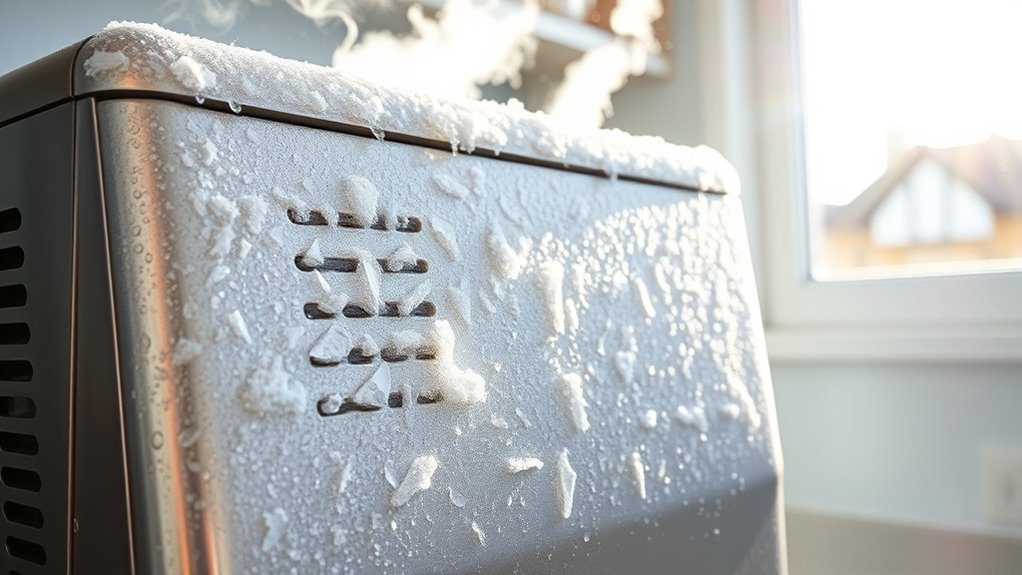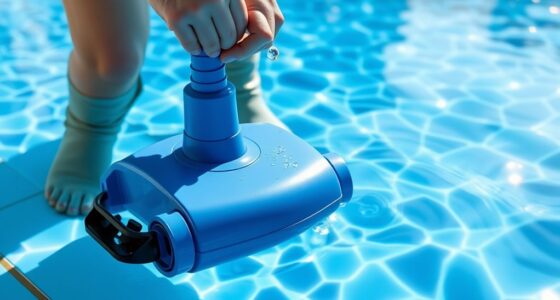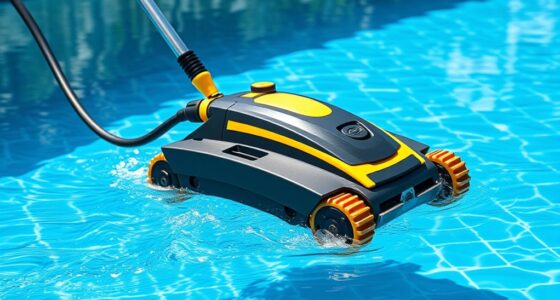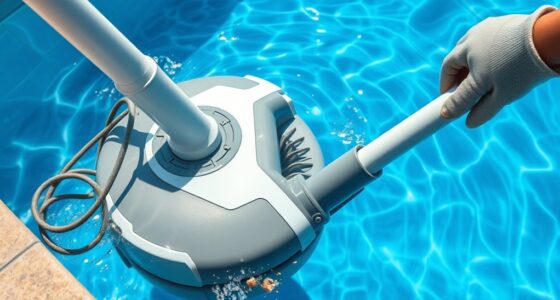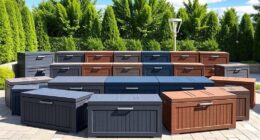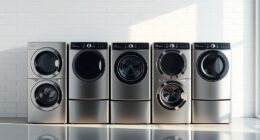In summer, your ice maker struggles because higher ambient temperatures make heat transfer more difficult, forcing the compressor to work harder. Increased demand and frequent cycling cause mechanical wear and strain on components, while poor insulation and dirty coils worsen heat dissipation. This overloads the system, leading to overheating and failures. Understanding the thermodynamics behind these issues helps you see why summer puts extra stress on your ice maker—keep exploring to find out more.
Key Takeaways
- Elevated ambient temperatures increase heat transfer challenges, forcing the refrigeration cycle to work harder and risking compressor overload.
- Frequent ice demand during summer causes mechanical wear due to rapid cycling and overloading of compressor components.
- Poor heat dissipation from dirty coils and inadequate insulation reduces efficiency, leading to overheating and potential failure.
- Limited storage capacity results in constant production cycles, overburdening the system and accelerating component wear.
- Inefficient energy use during hot weather strains the system, causing increased energy consumption and reducing overall lifespan.
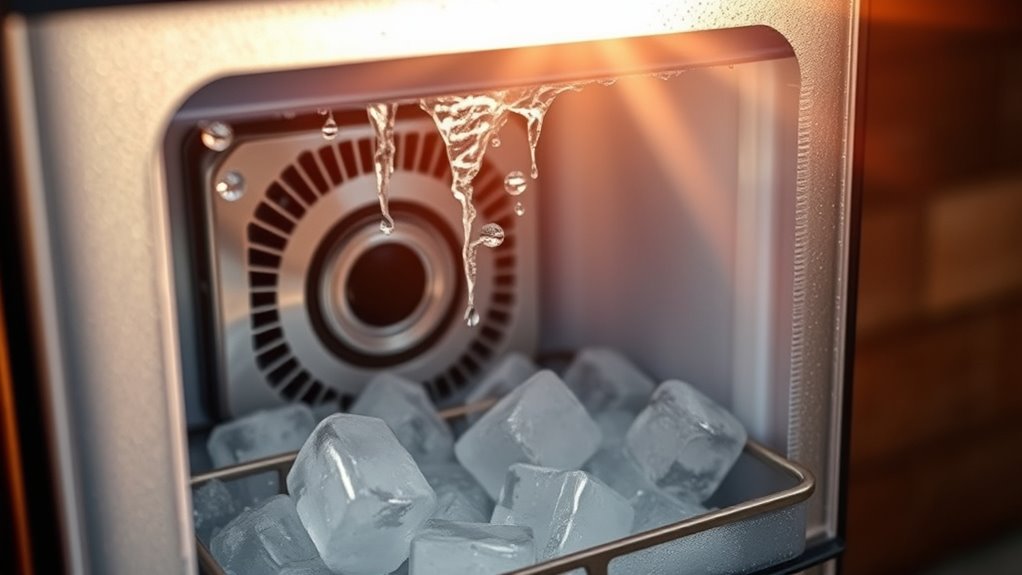
During the hot summer months, many ice makers struggle to keep up with increased demand, leading to frequent failures when you need ice the most. As temperatures climb, the thermodynamics behind ice production become more challenging. Your ice maker has to work harder to produce enough ice, but this increased workload often exposes weaknesses in its design, especially regarding energy efficiency and ice storage capacity. Poor insulation and dirty condenser coils can further hinder heat transfer, compounding the problem. Energy efficiency plays a vital role in how well your ice maker responds in summer. When it’s hot outside, the machine’s compressor and refrigeration cycle must operate more intensively to remove heat from water and convert it into ice. If your unit isn’t energy-efficient, it consumes more power to maintain the low temperatures needed for ice formation. This overload can cause components to overheat or fail prematurely. An efficient ice maker minimizes power consumption by optimizing compressor cycles and insulation, helping it handle summer’s heat without breaking down. Without this efficiency, your machine may run continuously, increasing wear and tear, and reducing its overall lifespan.
Ice storage is another essential factor. During summer, demand spikes, and your ice maker needs sufficient storage to hold the ice produced throughout the day. If the ice storage bin is too small, the machine works overtime to keep up, constantly cycling on and off. This constant cycling not only strains the compressor but also accelerates mechanical wear. Conversely, a larger ice storage capacity allows your machine to produce ice steadily, storing it for later use without overworking. Proper storage also helps maintain ice quality because it prevents the ice from melting quickly or becoming contaminated. When the storage is inadequate, the machine’s rapid cycling can lead to freezing issues and mechanical stress, causing failures. Additionally, heat transfer efficiency is crucial for maintaining optimal operation during hot weather. The thermodynamics of heat transfer come into play. The refrigeration cycle relies on transferring heat from inside the ice maker to the outside environment. In summer, the ambient heat makes this process more difficult. If your ice maker isn’t designed with sufficient insulation or if the condenser coils aren’t kept clean, the machine struggles to dissipate heat effectively. This inefficiency leads to higher energy consumption and potential overheating, which can cause the compressor to shut down or fail prematurely.
Frequently Asked Questions
How Does Ambient Temperature Affect Ice Maker Efficiency?
Ambient temperature directly impacts your ice maker’s efficiency. When ambient heat rises, it challenges the cooling efficiency of your machine, making it work harder to freeze water. Higher temperatures cause the compressor to run more frequently, increasing energy use and slowing ice production. To maintain ideal performance, you should guarantee good ventilation around your ice maker and consider lowering room temperatures if possible.
Can Improper Insulation Cause Ice Maker Failure in Summer?
Imagine your ice maker as a swimmer struggling against strong currents. Improper insulation quality allows heat transfer from the warm environment, just like water currents pulling them off course. When insulation isn’t effective, heat leaks in, forcing the machine to work harder or fail. In summer, poor insulation accelerates ice melt and hampers efficiency, making it more prone to breakdowns. Proper insulation keeps the heat transfer in check, ensuring smooth operation.
What Role Does Humidity Play in Ice Production?
Humidity impact greatly affects your ice maker’s efficiency. When humidity is high, moisture can accumulate inside, causing frost buildup and reducing ice production. You need moisture control to prevent this, guaranteeing your ice maker operates smoothly. Proper ventilation and dehumidifiers help manage humidity levels, keeping the environment ideal for ice-making. By controlling humidity, you ensure consistent ice production and prevent common summer failures caused by excess moisture.
Do Certain Materials Improve Ice Maker Performance in Heat?
Imagine you’re battling a heatwave so intense, only the finest materials can save your ice maker! Using materials with high conductivity, like copper or aluminum, allows heat to transfer away rapidly, keeping your ice maker cool. Meanwhile, superior insulation enhances effectiveness by blocking heat from entering. Together, these materials dramatically boost performance in summer heat, ensuring your ice stays icy and your machine runs smoothly.
How Often Should Maintenance Be Performed During Summer Months?
You should perform preventive maintenance on your ice maker at least once every three months during summer months. Regular checks help *guarantee* component durability and prevent buildup that hampers performance. During peak heat, more frequent cleaning of filters and inspection of moving parts keeps the system running smoothly. Staying proactive with maintenance minimizes breakdowns, extends your ice maker’s lifespan, and ensures you always have plenty of ice when you need it most.
Conclusion
So, next time your ice maker struggles in the summer heat, remember it’s all about thermodynamics at play. You can’t beat the laws of physics, after all. Isn’t it fascinating how these principles impact everyday appliances? Understanding this makes it easier to troubleshoot and keep your ice maker running smoothly. So, are you ready to outsmart the summer heat and keep your ice flowing?
